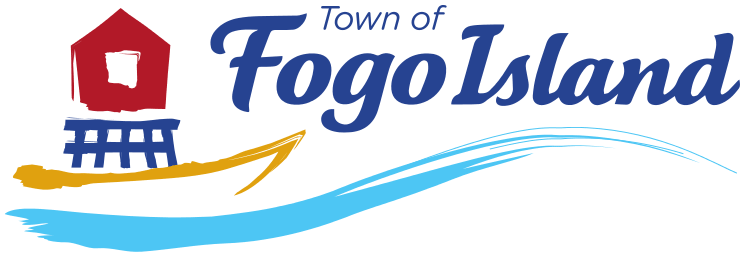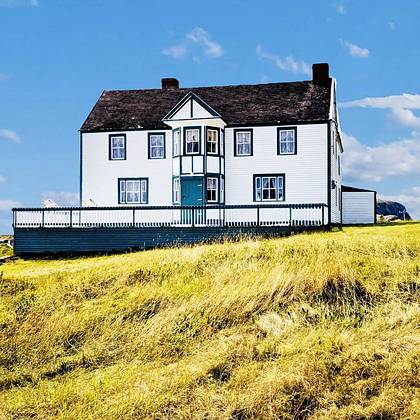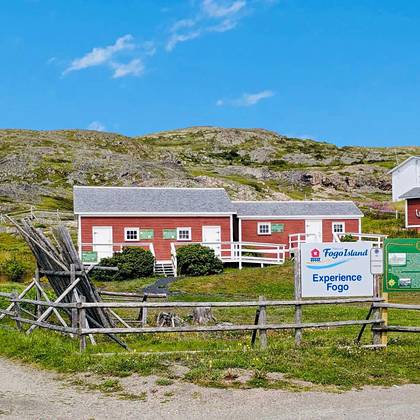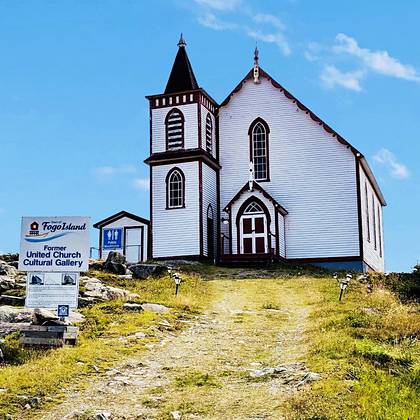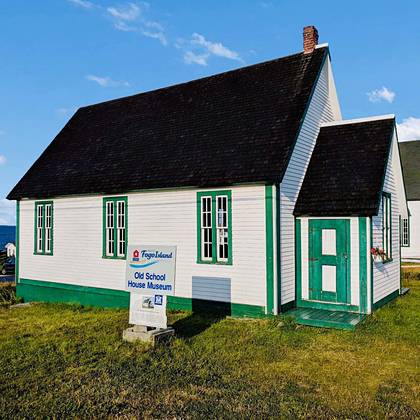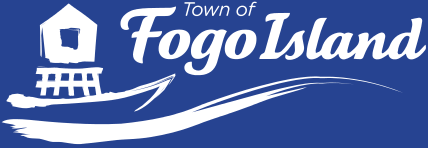Fogo
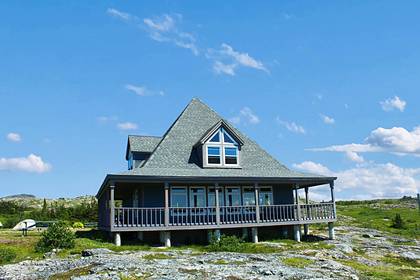
Marconi Wireless Interpretation Centre
Pickett's Road Extension, Fogo
49° 43' 10.47" N 54° 15' 47.06" W
Perched high on the hill above the community of Fogo, get a great view of the community and learn about the early communications history of Fogo Island.
Built in 1911 at the instigation of the Newfoundland government, the Marconi wireless station on Fogo Island was for many years the only one along the hundreds of kilometres of Newfoundland coast between Cape Race and Belle Isle. Built near the community of Fogo, it operated for 22 years and connected to an overland telegraph line, provided an invaluable communications link to local and passing mariners, and those bound to and from the Labrador fishery. It was also the main link to the Battle Harbour wireless station – through it the people of the Labrador Straits were linked to the North American "land line" telegraph network.
Today, behind the town of Fogo, the Marconi wireless station site is on a sightseeing path to the abandoned village of Lion's Den. Through interpretive panels, it tells the story of the ebb and flow of communities and cultures, and the important role wireless technology once played in keeping those in the fishery safe, prosperous and in touch.
Bleak House
North Shore Road, Fogo
49° 43' 04.91" N 54°17' 06.07" W
Home to some of the most powerful and influential people in the history of Fogo, Bleak House represents the differences between the merchant class and the fishing class in the community from a century ago.
The exact date that Bleak House was built is unknown, but it is suspected that the dwelling was built around 1816 for local merchant John Slade. The Slade family first became involved in the northern fishery around the middle of the eighteenth century. By the end of the century, they were the most powerful merchants in the Fogo Island fish trade, and their influence stretched into surrounding Notre Dame Bay.
Sometime around the middle of the nineteenth century, John Owens, formerly Slade's bookkeeper, took over the house and the business. Owens managed to become wealthy after entering into an advantageous marriage. He operated a successful business on Fogo Island until he retired to England in 1897, when his house and businesses were bought by his partner, Henry Earle.
The Earle family members were also influential merchants in the Fogo Island area. Running Earle Sons and Company Ltd., they operated a successful export and import business whose influence spread to other areas around Notre Dame and Bonavista Bays. In 1967 the family business was forced to close following the collapse of the Labrador fishery and the depletion of the Northern Cod stocks, and the Earles left the house.
The Slades, Owens and Earles were among the most powerful and influential families in the history of Fogo, and the house reflects this. The house's name is said to be a reference to the 1853 Charles Dickens novel of the same name. Originally Bleak House was a rectangular, two-storeyed, centre-hall dwelling with a salt-box roof. Many of the features of the interior and exterior of the house were reflections of prevailing architectural designs of West County England. During the late 1800s additions were made to the house, especially in the rear.
The location, appearance and size of the house indicate the importance of the families who lived there. Located on top of a hill, it overlooks the harbour and the rest of the community. It is located next to the business premises that used to be the heart of the Earle's commercial enterprises.
In 1983 the house was made a gift to the Town Council of Fogo. It was already beginning to fall into disrepair after being abandoned for so many years. The town received funding to restore the house and transform it into a museum. It was made a Registered Heritage Structure in December 1985 by the Heritage Foundation of Newfoundland and Labrador, and became the first building in the province to be restored through the foundation's restoration program. The Bleak House Museum has been open to the general public since 1988, and remains one of the best examples of successful, long-term adaptive reuse.
Experience Fogo Site
North Shore Road, Fogo
49° 43" 00.47" N 54° 17' 22.04" W
View collections of old tools and see how residents grew their own vegetables, raised their livestock, mended their nets, and dried their fish.
This parcel of land was once owned by the Slade merchant family, and then by the Earle's. It was later donated by merchant Henry Earle for the building of a cottage hospital, which closed in 2004 after fifty-one years in operation.
The site includes a number of elements – carpenter's shop, stable, traditional garden, stage and flakes – which would have been familiar in outport Newfoundland around a century ago.
The community of Fogo was permanently settled by Europeans, and a description of its fishery was recorded as early as 1697. These early fishers probably left for Britain in the Winters, but permanent settlers were living at Fogo by the 1720's (Winter population in 1738 – 143)
As the nearby stage and flakes remind us, Fogo existed because of the fishery. By the late 19th century the port was an important centre for cod harvesting: in 1891 twenty-five schooners sailed from Fogo to the Labrador fishery. A number of fish merchant houses were based at Fogo, including the Slades, Hodges and Earles. The residents of Fogo came mainly from West Country England and southeastern Ireland, with the number of residents standing at 1,118 in 1901. By this time Fogo was the unofficial capital of its district, with services like a blacksmith, coopers, a courthouse, police detachment and a resident doctor.
United Church
Main Street, Fogo
49° 42' 52.79" N 54° 16"52.41" W
A devastating fire destroyed the first Fogo Methodist Mission's church and much of Fogo Island in 1875. Within two years, Fogo's small Methodist community of approximately 140 people rebuilt the church. Its austere appearance shows the modest temperament of the people who donated their efforts and talents into rebuilding their place of worship.
Since 1925 the church has been part of the United Church of Canada. In 1948 a bell tower was added. The structure is vacant, as one central United Church has been built for all the United Church residents of Fogo Island. It is now used as an Art Gallery for the summer months and has a display of artifacts from the Society of United Fishermen.
The Heritage Foundation of Newfoundland and Labrador declared Fogo United Church a Registered Heritage Structure in May 1997.
Fogo Battery
The Fogo Battery was used to protect Fogo in the 1700's. Located on site are six cannons, a hiking trail, and an observation platform in which visitors can take advantage of the scenic views of the ocean and surrounding islands.
Take a hike to the top of Fogo Head - 338ft above sea level - and enjoy the views of whales, birds, and icebergs.
Old School House
The Old Schoolhouse is a rectangular, single-storey former school building with symmetrically placed wooden windows along the sides, a steeply pitched gable roof, and a front gable-end entry porch with wooden doors. It is located next to Our Lady of the Snows Roman Catholic Church on Main Street in Fogo. The building currently functions as a museum. The municipal heritage designation is confined to the footprint of the building.
The Old Schoolhouse has historic and aesthetic significance.
The Old Schoolhouse has historic value due to its age, its historical function, and its association with Fogo's Roman Catholic Congregation, which operated the school from 1888 to 1969.
The Old Schoolhouse has aesthetic value as a good example of a nineteenth century school building in Newfoundland. The simple, rectangular, single-storey form and overall symmetrical design produces a tidy appearance which is historically typical of one room schoolhouses in the province. The influence of Gothic Revival architecture is seen in the steeply pitched rooflines of both the body of the building and the small porch centred in the front gable end and the long, regularly placed, multi-paned windows. The porch has a panel-style wooden door at each side, purportedly so that girls and boys would enter the school separately at their delegated side. The brick chimney at the front gable end harks back to the time when such school buildings were heated by woodstoves.
The Old Schoolhouse has aesthetic value amongst a cluster of historic ecclesiastical properties visible along Fogo's Main street, including St. Andrew's Anglican Church and Cemetery, Fogo United Church and Our Lady of the Snows Roman Catholic Church. The schoolhouse's close proximity to the latter church, along with common elements of the two buildings (steep roof, rectangular building design with short façade, white and green colour scheme), clearly implies an historic connection between the two nineteenth century Catholic buildings at the centre of Fogo's cultural landscape.
